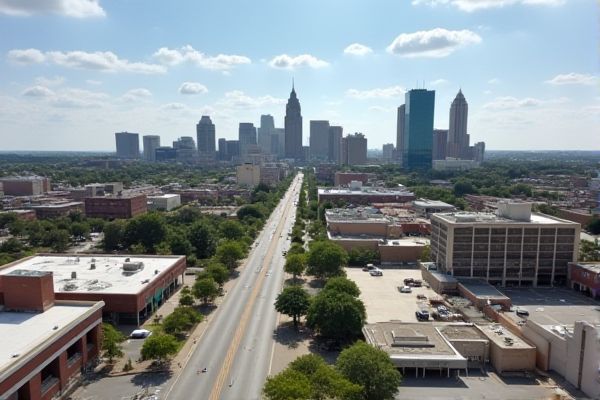
What to know as new resident in Oklahoma: Tornado safety and preparedness. Local weather variations. Cost of living insights. Popular local foods. Important state laws. Educational opportunities. Healthcare facilities availability. Community and cultural events. Vehicle registration process. Local public transport options.
Tornado safety and preparedness.
As a new resident in Oklahoma, it is crucial to stay informed about weather updates, identify a safe shelter such as a storm shelter, basement, or innermost room on the lowest level, and prepare an emergency kit. Additionally, practice tornado drills, secure your home, and wear protective gear like helmets and sturdy shoes to minimize risks during a tornado. For comprehensive guidance on tornado preparedness, visit the Prepare OKC page, which offers essential resources and tips to safeguard yourself and your family during severe weather events.
Local weather variations.
Oklahoma's climate exhibits considerable variation, transitioning from humid subtropical conditions in the east to semi-arid environments in the west. The state frequently endures hot summers, particularly in western regions, with temperatures often soaring above 100°F. Winters, however, tend to be mild, interspersed with sporadic cold snaps. Precipitation patterns show a marked decline from east to west, with the southeast receiving up to 56 inches annually, contrasting sharply with the mere 17 inches characteristic of the western panhandle. Thunderstorms are a common occurrence, especially during late spring and early summer, bringing a blend of convective and stratiform precipitation year-round. For more detailed information on these climatic patterns, you can explore the Oklahoma Climate resources on the University of Oklahoma's website.
Cost of living insights.
The cost of living in Oklahoma is notably 12% lower than the national average, presenting a significant advantage for residents. Most prominently, housing costs are 28% lower, making it an attractive destination for those seeking affordable living arrangements. Utilities are also reduced by 4%, offering additional savings on monthly expenses. Furthermore, the reductions in food, healthcare, transportation, and goods & services costs range from 4% to 7% below the national average, contributing to the overall affordability of living in this state. For a more detailed analysis, you can explore the Cost of Living Calculator, which provides comprehensive insights into these cost differences.
Popular local foods.
Oklahoma is renowned for a diverse array of local foods, which are an integral part of the state's culinary heritage. Among the most celebrated dishes are Oklahoma Barbecue, Fried Onion Burgers, Chicken Fried Steak, Fried Okra, Calf Fries, and Fried Catfish. These dishes, along with Sooner Steaks, Biscuits and Sausage Gravy, Grits, and Cornbread, capture the essence of Oklahoma's rich food culture. To explore more about these iconic dishes, visit the Only In Your State website, where you can discover the stories and traditions behind each flavorful creation.
Important state laws.
To establish residency in Oklahoma, an individual must have a bona fide residence in the state for at least 60 consecutive days, with proof of residency such as a valid driver's license, property tax receipts, or other public records. Residency status can also be affected by military service and other specific conditions. For more detailed information on residency requirements and related statutes, you can refer to the Oklahoma State Codes, which provide comprehensive guidelines and exceptions that may apply under various circumstances.
Educational opportunities.
Oklahoma offers a variety of educational opportunities, including private school choice programs such as vouchers and tax-credit scholarships, charter schools, magnet schools, inter-district public school choice, and homeschooling options. Recently, Oklahoma enacted a universal School Choice program, providing up to $7,500 per child for private school tuition and a $1,000 tax credit for homeschooling expenses.
Healthcare facilities availability.
In Oklahoma, healthcare facilities, particularly nursing homes, are set to receive a significant increase in Medicaid funding, with over $100 million in state and federal funds allocated to improve long-term care provider rates, including direct care and other costs. This infusion aims to address staffing shortages and enhance the quality of care. The Oklahoma Health Care Authority Board has approved the rate increase, signaling a crucial step towards better healthcare service delivery for the state's elderly population.
Community and cultural events.
Oklahoma offers a vibrant array of community and cultural events, including festivals like the Porter Peach Festival, Rush Springs Watermelon Festival, FireLake Fireflight Balloon Fest, and the Guymon Fiesta, each celebrating local culture, music, art, and traditions with various activities such as live music, food booths, carnival rides, and unique competitions. These events showcase the state's diverse cultural heritage and provide numerous opportunities for community engagement and celebration. For a comprehensive guide to these exciting festivals, visit the 2023 Oklahoma Festival Guide and explore the rich tapestry of traditions and entertainment that define the spirit of Oklahoma.
Vehicle registration process.
If you're a new resident in Oklahoma, registering your vehicle involves several essential steps. Firstly, ensure that you have collected all the necessary documents, such as the out-of-state title, an application for the Oklahoma title, and proof of insurance. Your next step is to visit a tag agency where you will submit these documents and pay the required fees. Depending on your vehicle, a vehicle inspection might be necessary before you can complete the process. To streamline your experience, you can refer to the Detailed Guide for New Oklahoma Residents to ensure you receive your Oklahoma license plates within the specified timeframe.
Local public transport options.
As a new resident in Oklahoma City, you can utilize EMBARK, the public transit system, which offers bus services with 23 routes, including connections to Midwest City and Norman, as well as a downtown streetcar system. EMBARK provides various fare options, including single-trip fares, unlimited ride passes, and reduced fares for eligible groups. To learn more about their services and explore your transit options, visit the official EMBARK website. Whether commuting daily or exploring the city, you'll find a convenient and efficient solution catered to your transit needs.
